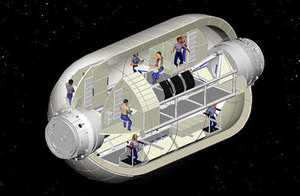Bigelow Aerospace has a dream to create hotels in space using inflatable, expandable modules. Awarded a $17.8 million contract by NASA this week, Bigelow, owned by Robert Bigelow of Budget Suites of America, plans to launch an inflatable module into space where it will remain for two years and serve as a storage module attached to the ISS. A news conference is planned for January 16 at Bigelow’s headquarters in Las Vegas, Nevada.
Bigelow, featured in past articles, has worked with the Russian space program for several years and previously launched two inflatables, Genesis 1 and 2. The former went into space in 2006. The latter in 2007. Both remain in orbit.
In the two images below on the left is a full-scale Bigelow module, and on the right the ISS with module attached. The current contract would be for a smaller inflatable than what is displayed here but Bigelow’s goal is to send modules with greatly expanded living space into orbit and eventually the Moon to serve as human habitations.
In the NASA media advisory it refers to a Bigelow Expandable Activity Module. We will know a lot more about what exactly is planned on this coming Wednesday. The conference is scheduled for 1:30 p.m. Eastern Standard Time.


















Aawesome, more jobs &
Ive just entered the Axe Apollo Space Academy to send 22 winners into Space.
another way to push Commercial Manned Space.
They will have to start thinking of ways of minimizing cosmic ray exposure after the whole “space travel causes” Alzheimer’s craze…
Hi David, The nice thing about inflatables is you can place shielding content on the interior walls or added to the exterior. Bigelow talks about using the consumables like water and storing it so that it effectively minimizes cosmic ray exposure to those inside the habitat.